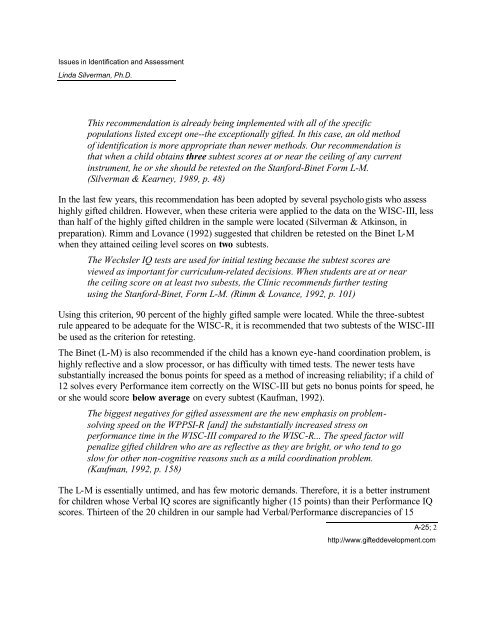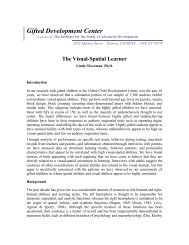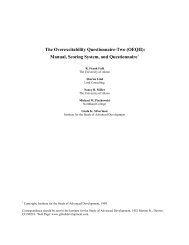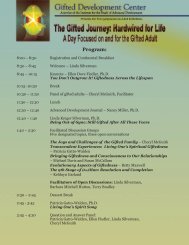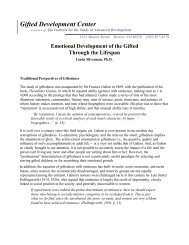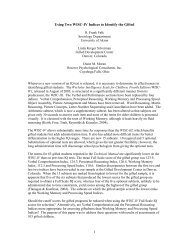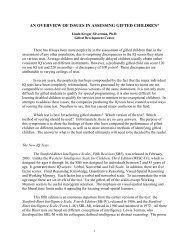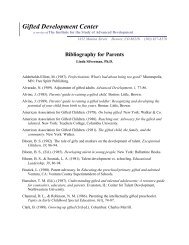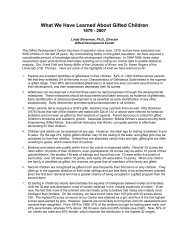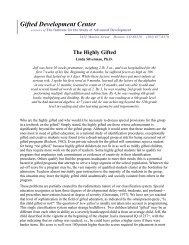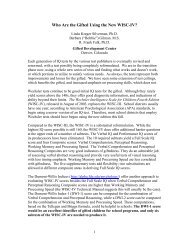Issues in Identification and Assessment - the Gifted Development ...
Issues in Identification and Assessment - the Gifted Development ...
Issues in Identification and Assessment - the Gifted Development ...
You also want an ePaper? Increase the reach of your titles
YUMPU automatically turns print PDFs into web optimized ePapers that Google loves.
<strong>Issues</strong> <strong>in</strong> <strong>Identification</strong> <strong>and</strong> <strong>Assessment</strong><br />
L<strong>in</strong>da Silverman, Ph.D.<br />
This recommendation is already be<strong>in</strong>g implemented with all of <strong>the</strong> specific<br />
populations listed except one--<strong>the</strong> exceptionally gifted. In this case, an old method<br />
of identification is more appropriate than newer methods. Our recommendation is<br />
that when a child obta<strong>in</strong>s three subtest scores at or near <strong>the</strong> ceil<strong>in</strong>g of any current<br />
<strong>in</strong>strument, he or she should be retested on <strong>the</strong> Stanford-B<strong>in</strong>et Form L-M.<br />
(Silverman & Kearney, 1989, p. 48)<br />
In <strong>the</strong> last few years, this recommendation has been adopted by several psychologists who assess<br />
highly gifted children. However, when <strong>the</strong>se criteria were applied to <strong>the</strong> data on <strong>the</strong> WISC-III, less<br />
than half of <strong>the</strong> highly gifted children <strong>in</strong> <strong>the</strong> sample were located (Silverman & Atk<strong>in</strong>son, <strong>in</strong><br />
preparation). Rimm <strong>and</strong> Lovance (1992) suggested that children be retested on <strong>the</strong> B<strong>in</strong>et L-M<br />
when <strong>the</strong>y atta<strong>in</strong>ed ceil<strong>in</strong>g level scores on two subtests.<br />
The Wechsler IQ tests are used for <strong>in</strong>itial test<strong>in</strong>g because <strong>the</strong> subtest scores are<br />
viewed as important for curriculum-related decisions. When students are at or near<br />
<strong>the</strong> ceil<strong>in</strong>g score on at least two subests, <strong>the</strong> Cl<strong>in</strong>ic recommends fur<strong>the</strong>r test<strong>in</strong>g<br />
us<strong>in</strong>g <strong>the</strong> Stanford-B<strong>in</strong>et, Form L-M. (Rimm & Lovance, 1992, p. 101)<br />
Us<strong>in</strong>g this criterion, 90 percent of <strong>the</strong> highly gifted sample were located. While <strong>the</strong> three-subtest<br />
rule appeared to be adequate for <strong>the</strong> WISC-R, it is recommended that two subtests of <strong>the</strong> WISC-III<br />
be used as <strong>the</strong> criterion for retest<strong>in</strong>g.<br />
The B<strong>in</strong>et (L-M) is also recommended if <strong>the</strong> child has a known eye-h<strong>and</strong> coord<strong>in</strong>ation problem, is<br />
highly reflective <strong>and</strong> a slow processor, or has difficulty with timed tests. The newer tests have<br />
substantially <strong>in</strong>creased <strong>the</strong> bonus po<strong>in</strong>ts for speed as a method of <strong>in</strong>creas<strong>in</strong>g reliability; if a child of<br />
12 solves every Performance item correctly on <strong>the</strong> WISC-III but gets no bonus po<strong>in</strong>ts for speed, he<br />
or she would score below average on every subtest (Kaufman, 1992).<br />
The biggest negatives for gifted assessment are <strong>the</strong> new emphasis on problemsolv<strong>in</strong>g<br />
speed on <strong>the</strong> WPPSI-R [<strong>and</strong>] <strong>the</strong> substantially <strong>in</strong>creased stress on<br />
performance time <strong>in</strong> <strong>the</strong> WISC-III compared to <strong>the</strong> WISC-R... The speed factor will<br />
penalize gifted children who are as reflective as <strong>the</strong>y are bright, or who tend to go<br />
slow for o<strong>the</strong>r non-cognitive reasons such as a mild coord<strong>in</strong>ation problem.<br />
(Kaufman, 1992, p. 158)<br />
The L-M is essentially untimed, <strong>and</strong> has few motoric dem<strong>and</strong>s. Therefore, it is a better <strong>in</strong>strument<br />
for children whose Verbal IQ scores are significantly higher (15 po<strong>in</strong>ts) than <strong>the</strong>ir Performance IQ<br />
scores. Thirteen of <strong>the</strong> 20 children <strong>in</strong> our sample had Verbal/Performance discrepancies of 15<br />
A-25; 2<br />
http://www.gifteddevelopment.com


